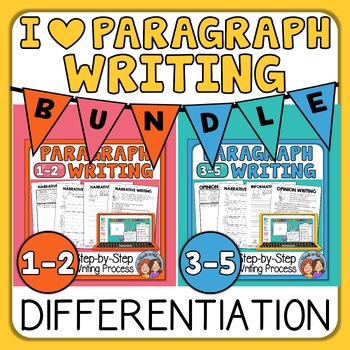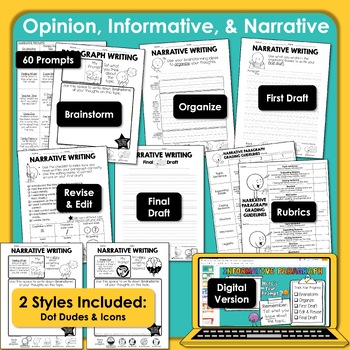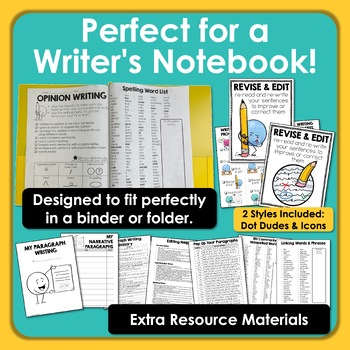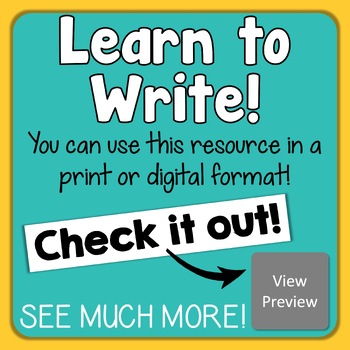Paragraph Writing of the Week Graphic Organizers- Differentiation for Grades 2-3
- Zip
- Google Apps™
- Easel Activity

What educators are saying
Products in this Bundle (2)
Description
Differentiate paragraph writing for 2nd and 3rd graders with this how to write a paragraph bundle! This bundle includes resources that include standards for 1st, 2nd, 3rd, 4th, and 5th grade!
The prompts are mostly the same, but the 1-2 set has simpler instruction text and larger writing lines, and grade-appropriate clip art. The 3-5 set has smaller, more detailed text and smaller lines for longer student input as well as clip art for older students.
This bundle includes 2 resources:
CHECK OUT THE PREVIEW TO SEE EACH RESOURCE IN GREATER DETAIL!
Great for differentiation in 2nd and 3rd grade!
Here’s what teachers are saying:
✏️ "I really appreciate the margin notes and checklists to keep kids on track and help them self-assess throughout the process. The handouts even come with a section that lets them track their progress through the writing process. This is something I was not sure how to manage when I was in the classroom before distance learning began, and I am so excited to have a product that is so organized and includes information that promotes students' independence during our writing block. I am excited to use this next year." -Shantrell C.
✏️ "This has been a great tool to use with my students. I recently found out this is something my third grade team has been using, so it has been nice to have consistency within the building. Plus I bought both 1-2 and 3-4, so I can differentiate for my 3/4 grade students." -Emilie U.
✏️ "These writing prompts and organizers are an awesome resource for developing writing skills. I used them in class at school, and am so happy they are now digital so I can continue using them as we transition to remote learning. The different pages provided for each step in the writing process are really awesome." -Drew H.
Common Core Standards:
CCSSW.1.1
Write opinion pieces in which they introduce the topic or name the book they are writing about, state an opinion, supply a reason for the opinion, and provide some sense of closure.
CCSSW.1.2
Write informative/explanatory texts in which they name a topic, supply some facts about the topic, and provide some sense of closure.
CCSSW.1.3
Write narratives in which they recount two or more appropriately sequenced events, include some details regarding what happened, use temporal words to signal event order, and provide some sense of closure.
CCSSW.1.5
With guidance and support from adults, focus on a topic, respond to questions and suggestions from peers, and add details to strengthen writing as needed.
CCSSW.1.8
With guidance and support from adults, recall information from experiences or gather information from provided sources to answer a question.
CCSSW.2.1
Write opinion pieces in which they introduce the topic or book they are writing about, state an opinion, supply reasons that support the opinion, use linking words (e.g., because, and, also) to connect opinion and reasons, and provide a concluding statement or section.
CCSSW.2.2
Write informative/explanatory texts in which they introduce a topic, use facts and definitions to develop points, and provide a concluding statement or section.
CCSSW.2.3
Write narratives in which they recount a well-elaborated event or short sequence of events, include details to describe actions, thoughts, and feelings, use temporal words to signal event order, and provide a sense of closure.
CCSSW.2.5
With guidance and support from adults and peers, focus on a topic and strengthen writing as needed by revising and editing.
CCSSW.2.8
Recall information from experiences or gather information from provided sources to answer a question.
CCSSW.3.1
Write opinion pieces on topics or texts, supporting a point of view with reasons.
CCSSW.3.2
Write informative/explanatory texts to examine a topic and convey ideas and information clearly.
CCSSW.3.3
Write narratives to develop real or imagined experiences or events using effective technique, descriptive details, and clear event sequences.
CCSSW.3.4
With guidance and support from adults, produce writing in which the development and organization are appropriate to task and purpose.
CCSSW.3.5
With guidance and support from peers and adults, develop and strengthen writing as needed by planning, revising, and editing.
CCSSW.3.8
Recall information from experiences or gather information from print and digital sources; take brief notes on sources and sort evidence into provided categories.
CCSSW.3.10
Write routinely over extended time frames (time for research, reflection, and revision) and shorter time frames (a single sitting or a day or two) for a range of discipline-specific tasks, purposes, and audiences.
CCSSW.4.1
Write opinion pieces on topics or texts, supporting a point of view with reasons and information.
CCSSW.4.2
Write informative/explanatory texts to examine a topic and convey ideas and information clearly.
CCSSW.4.3
Write narratives to develop real or imagined experiences or events using effective technique, descriptive details, and clear event sequences.
CCSSW.4.4
Produce clear and coherent writing in which the development and organization are appropriate to task, purpose, and audience.
CCSSW.4.5
With guidance and support from peers and adults, develop and strengthen writing as needed by planning, revising, and editing.
CCSSW.4.8
Recall relevant information from experiences or gather relevant information from print and digital sources; take notes and categorize information, and provide a list of sources.
CCSSW.4.10
Write routinely over extended time frames (time for research, reflection, and revision) and shorter time frames (a single sitting or a day or two) for a range of discipline-specific tasks, purposes, and audiences.
CCSSW.5.1
Write opinion pieces on topics or texts, supporting a point of view with reasons and information.
CCSSW.5.1a
Introduce a topic or text clearly, state an opinion, and create an organizational structure in which ideas are logically grouped to support the writer’s purpose.
CCSSW.5.1b
Provide logically ordered reasons that are supported by facts and details.
CCSSW.5.1c
Link opinion and reasons using words, phrases, and clauses (e.g., consequently, specifically).
CCSSW.5.1d
Provide a concluding statement or section related to the opinion presented.
CCSSW.5.2
Write informative/explanatory texts to examine a topic and convey ideas and information clearly.
CCSSW.5.2a
Introduce a topic clearly, provide a general observation and focus, and group related information logically; include formatting (e.g., headings), illustrations, and multimedia when useful to aiding comprehension.
CCSSW.5.2b
Develop the topic with facts, definitions, concrete details, quotations, or other information and examples related to the topic.
CCSSW.5.2c
Link ideas within and across categories of information using words, phrases, and clauses (e.g., in contrast, especially).
CCSSW.5.2d
Use precise language and domain-specific vocabulary to inform about or explain the topic.
CCSSW.5.2e
Provide a concluding statement or section related to the information or explanation presented.
CCSSW.5.3
Write narratives to develop real or imagined experiences or events using effective technique, descriptive details, and clear event sequences.
CCSSW.5.3a
Orient the reader by establishing a situation and introducing a narrator and/or characters; organize an event sequence that unfolds naturally.
CCSSW.5.3b
Use narrative techniques, such as dialogue, description, and pacing, to develop experiences and events or show the responses of characters to situations.
CCSSW.5.3c
Use a variety of transitional words, phrases, and clauses to manage the sequence of events.
CCSSW.5.3d
Use concrete words and phrases and sensory details to convey experiences and events precisely.
CCSSW.5.4
Produce clear and coherent writing in which the development and organization are appropriate to task, purpose, and audience.
CCSSW.5.5
With guidance and support from peers and adults, develop and strengthen writing as needed by planning, revising, editing, rewriting, or trying a new approach.
CCSSW.5.10
Write routinely over extended time frames (time for research, reflection, and revision) and shorter time frames (a single sitting or a day or two) for a range of discipline-specific tasks, purposes, and audiences.
CCSSW.3.1a
Introduce the topic or text they are writing about, state an opinion, and create an organizational structure that lists reasons.
CCSSW.3.1b
Provide reasons that support the opinion.
CCSSW.3.1c
Use linking words and phrases (e.g., because, therefore, since, for example) to connect opinion and reasons.
CCSSW.3.1d
Provide a concluding statement or section.
CCSSW.3.2a
Introduce a topic and group related information together; include illustrations when useful to aiding comprehension.
CCSSW.3.2b
Develop the topic with facts, definitions, and details.
CCSSW.3.2c
Use linking words and phrases (e.g., also, another, and, more, but) to connect ideas within categories of information.
CCSSW.3.2d
Provide a concluding statement or section.
CCSSW.3.3a
Establish a situation and introduce a narrator and/or characters; organize an event sequence that unfolds naturally.
CCSSW.3.3c
Use temporal words and phrases to signal event order.
CCSSW.3.3d
Provide a sense of closure.
CCSSW.4.1a
Introduce a topic or text clearly, state an opinion, and create an organizational structure in which related ideas are grouped to support the writer’s purpose.
CCSSW.4.1b
Provide reasons that are supported by facts and details.
CCSSW.4.1c
Link opinion and reasons using words and phrases (e.g., for instance, in order to, in addition).
CCSSW.4.1d
Provide a concluding statement or section related to the opinion presented.
CCSSW.4.2b
Develop the topic with facts, definitions, concrete details, quotations, or other information and examples related to the topic.
CCSSW.4.2c
Link ideas within categories of information using words and phrases (e.g., another, for example, also, because).
CCSSW.4.2d
Use precise language and domain-specific vocabulary to inform about or explain the topic.
CCSSW.4.2e
Provide a concluding statement or section related to the information or explanation presented.
CCSSW.4.3a
Orient the reader by establishing a situation and introducing a narrator and/or characters; organize an event sequence that unfolds naturally.
CCSSW.4.3b
Use dialogue and description to develop experiences and events or show the responses of characters to situations.
CCSSW.4.3c
Use a variety of transitional words and phrases to manage the sequence of events.
CCSSW.4.3d
Use concrete words and phrases and sensory details to convey experiences and events precisely.
CCSSW.4.3e
Provide a conclusion that follows from the narrated experiences or events.
____________________________________
Be the first to know about discounts, freebies and new resources!
- Follow us on TpT.
- Join our Teachers Club.
- Check out our Blog www.Minds-in-Bloom.com
- Follow us on Social Media - Facebook or Instagram
Get TPT credit to use on future purchases:
- Go to your My Purchases page.
- Click on the Provide Feedback button to leave a rating and a short comment.
- You’ll earn TPT credits, which you can redeem on future purchases!
⭐⭐⭐⭐⭐ WE STRIVE FOR 5 STARS! ⭐⭐⭐⭐⭐
NEED HELP? Before leaving feedback:
- Visit the FAQs section
- submit a help ticket
- ask a question on the Q& A tab
About the Author
Rachel Lynette is a published author of over 120 nonfiction books for children on a variety of subjects, as well as several teacher resource books. She has written for publishers such as Harcourt, Thompson-Gale, Rosen, Children’s Press, Evan-Moor, Kagan, and several others. This resource reflects more than a decade of professional writing experience.
Terms of Use
This resource was created by Rachel Lynette and Cassi Noack for Minds in Bloom INC., all rights reserved. It may be used by the original purchaser for single class use only. Teachers may distribute this product in email, through google classroom or over the Internet to their students (and parents) as long as the site is password protected. In other words, you may distribute it to your own students, but may not put it on the Internet where it could be publicly found and downloaded.
If you want to share this resource with colleagues, please purchase additional licenses from TpT. Thank you for respecting these terms of use.
This product is happily brought to you by Rachel Lynette and Cassi Noack of Minds in Bloom
SKU: 4105015





